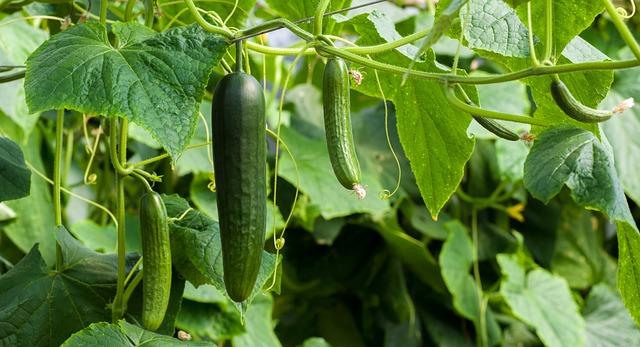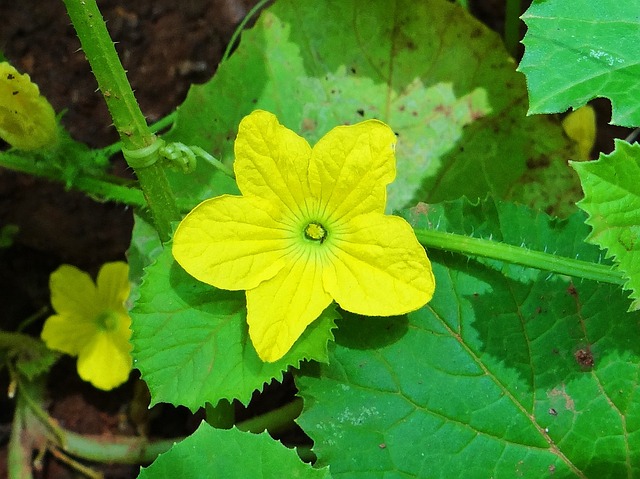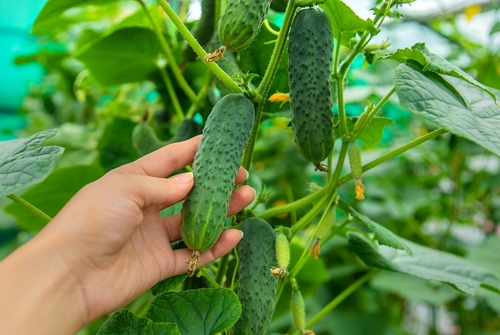White spots on cucumber leaves can be a frustrating problem for gardeners. These spots can be a sign of a variety of issues, from pests to diseases, and can quickly spread if not addressed promptly. Fortunately, there are several treatment options available to help control and prevent white spots on cucumber leaves.
Understanding the causes of white spots on cucumber leaves is the first step in diagnosing and treating the issue. One common cause is powdery mildew, a fungal disease that appears as white or gray spots on the leaves.
Other potential causes include pests such as spider mites or thrips, or even environmental factors such as excessive heat or humidity.
Once the problem has been diagnosed, there are several treatment options available. These may include applying fungicides or insecticides, removing affected leaves, or simply adjusting environmental conditions to prevent further spread of the issue.
By taking a proactive approach to cucumber plant care and staying vigilant for signs of white spots on leaves, gardeners can help ensure healthy, productive plants.
Key Takeaways
- Understanding the causes of white spots on cucumber leaves is crucial for effective treatment and prevention.
- Treatment options may include applying fungicides or insecticides, removing affected leaves, or adjusting environmental conditions.
- Proper cucumber plant care, including regular pruning and maintenance, can help prevent white spots and other issues from occurring.
Also don’t miss:
Understanding White Spots on Cucumber Leaves

White spots on cucumber leaves are a common problem that gardeners face. These spots are usually caused by a fungal disease known as powdery mildew. Powdery mildew is a fungus that grows on the surface of leaves and other plant parts, causing them to appear white or grayish-white in color.
The fungus infects the leaves of the cucumber plant, starting from the lower shaded leaves. The fungus feeds on the plant nutrients, spreads across the leaf surface, disperses to other leaves, blocks sunlight that prevents photosynthesis, and ultimately starves the cucumber plants to death.
Powdery mildew is most common in warm, humid weather and can spread rapidly in crowded or poorly ventilated gardens. Once the fungus has taken hold, it can be difficult to control, but early intervention can often prevent the spread of the disease.
There are several factors that can contribute to the development of powdery mildew on cucumber plants, including:
- Humidity levels
- Poor air circulation
- Crowded planting
- Overhead watering
- High nitrogen levels
To prevent powdery mildew, it’s important to keep the cucumber plants healthy and well-maintained. This includes regular pruning to promote air circulation, avoiding overhead watering, and removing any infected leaves or plants as soon as possible.
If white spots do appear on the cucumber leaves, there are several treatment options available. These include:
- Fungicides: Fungicides can be used to treat the white spots on cucumbers if they are caught early. The purpose of fungicides is to prevent the fungi spores from germinating. There are a variety of fungicides that you can choose from. Just make sure it is appropriate for cucumbers and powdery mildew.
- Homemade remedies: There are several homemade remedies that can be used to control powdery mildew. These include a mixture of baking soda and water, or a solution of milk and water. These remedies can be sprayed directly onto the affected leaves and plants.
- Neem oil: Neem oil is a natural insecticide and fungicide that can be used to control powdery mildew. It works by disrupting the life cycle of the fungus and preventing it from reproducing.
White Spots on Cucumber Leaves – 4 Common Problems
White spots on cucumber leaves can be caused by a variety of factors, including fungal and bacterial infections, environmental factors, and pests. It is important to identify the underlying cause of the white spots to determine the appropriate treatment.
1. Fungal Infections
Fungal infections are one of the most common causes of white spots on cucumber leaves. Powdery mildew, caused by the fungi Erysiphe cichoracearum or Podosphaera fuliginea, is a common fungal disease that affects cucumbers.
It typically appears as white spots on the leaves and stems, which can spread rapidly in high humidity and poor air circulation conditions. Downy mildew, caused by the fungal pathogen Pseudoperonospora cubensis, can also cause white spots on cucumber leaves.
2. Pests

Spider mites and thrips are common pests that can cause white spots on cucumber leaves. Spider mites damage the leaves by sucking the sap, causing small white spots to appear. Thrips, on the other hand, feed on the leaves and cause small white patches to appear.
3. Bacterial Infections
Bacterial wilt, angular leaf spot, and anthracnose are bacterial diseases that can cause white spots on cucumber leaves. Bacterial wilt, caused by the bacterium Erwinia tracheiphila, is a serious disease that can cause the leaves to wilt and turn yellow.
Angular leaf spot, caused by the bacterium Pseudomonas syringae pv. lachrymans, can cause white spots on the leaves and stems. Anthracnose, caused by the fungus Colletotrichum orbiculare, can also cause white spots on cucumber leaves.
4. Viral Infections
Cucumber mosaic virus is a viral disease that can cause white spots on cucumber leaves. The virus is spread by aphids and can cause the leaves to curl and become distorted.
In summary, white spots on cucumber leaves can be caused by a variety of factors, including fungal and bacterial infections, pests, and viral infections. Identifying the underlying cause of the white spots is crucial to determine the appropriate treatment.
Diagnosing the Problem
When it comes to diagnosing the problem of white spots on cucumber leaves, there are several factors to consider. High humidity and temperature are common culprits, as they create the perfect environment for fungus growth.
Additionally, the health of the plant itself can play a role, with stressed plants being more susceptible to disease. One common fungus that causes white spots on cucumber leaves is Podosphaera fuliginea, also known as powdery mildew.
This fungus thrives in warm, humid conditions and can spread rapidly if not treated promptly. Excessive moisture can also contribute to fungal infections, so it’s important to ensure proper drainage and avoid overwatering.
Other diseases that can cause white spots on cucumber leaves include Fusarium wilt, bacterial wilt, and cucumber mosaic virus. These diseases can also cause other symptoms such as stunted growth, fallen leaves, and wilted appearance.
Transplant shock is another possible cause of white spots on cucumber leaves. When plants are moved from one location to another, they can become stressed and more susceptible to disease. Leafhoppers can also transmit disease to cucumber plants, so it’s important to keep an eye out for these pests.
Water stress can also contribute to the development of white spots on cucumber leaves. When plants are not receiving enough water, they become stressed and more susceptible to disease. On the other hand, overwatering can lead to excessive moisture and fungal infections.
Finally, bacterial leaf spot caused by Pseudomonas syringae can also cause white spots on cucumber leaves. This disease can cause angular, water-soaked lesions on leaves and stems.
To diagnose the problem, it’s important to closely examine the affected leaves and look for any additional symptoms. It may also be helpful to consult with a gardening expert or extension agent for further guidance.
In some cases, planting resistant varieties or using sulfur treatments may be effective in preventing the spread of disease.
Treatment Options for White Spots

When it comes to treating white spots on cucumber leaves, there are a number of different options available. The best treatment option will depend on the severity of the infestation and the gardener’s personal preferences.
Organic Treatments
For those who prefer to use organic treatments, there are a few different options available. One of the most popular is neem oil, which is a natural insecticide and fungicide. Another option is horticultural oil, which is made from petroleum and can be used to suffocate the spores that cause powdery mildew.
Other organic treatments include a homemade baking soda solution, which can be made by mixing baking soda and water, and a milk spray, which is made by mixing milk and water. Garlic is also a natural fungicide that can be used to treat powdery mildew.
Chemical Fungicides
For those who prefer to use chemical fungicides, there are a number of different options available. One of the most effective is sulfur, which can be used to kill the spores that cause powdery mildew. Copper fungicides are also effective at treating powdery mildew.
In severe cases, a chemical fungicide may be necessary. These fungicides are designed to kill the spores that cause powdery mildew, and they can be very effective at stopping the spread of the disease. However, it is important to use these fungicides carefully, as they can be harmful to beneficial insects and other organisms.
Other Treatment Options
In addition to the treatments mentioned above, there are a few other options available for treating white spots on cucumber leaves. One of the most popular is a baking soda and water solution, which can be sprayed directly onto the affected leaves to kill the spores that cause powdery mildew.
Pesticides are also an option, although they should be used sparingly and only as a last resort. It is important to read the label carefully and follow all instructions when using pesticides, as they can be harmful to both humans and the environment.
Preventing White Spots on Cucumber Leaves
Prevention is the key to avoiding white spots on cucumber leaves. Proper care and maintenance of cucumber plants can help prevent the occurrence of white spots.
One of the most effective ways to prevent white spots on cucumber leaves is to choose resistant cucumber varieties. Disease-resistant varieties are specifically bred to resist common fungal and bacterial diseases that affect cucumbers, including powdery mildew, which is a common cause of white spots on cucumber leaves.
Watering is also an important factor in preventing white spots on cucumber leaves. Overwatering can lead to excessive moisture, which can create a favorable environment for fungal and bacterial infections. It is recommended to water cucumbers deeply and infrequently, allowing the soil to dry out between watering sessions.
Sunlight exposure and air circulation are also important factors in preventing white spots on cucumber leaves. Cucumbers need direct sunlight to thrive, and a lack of sunlight can lead to weak plants that are more susceptible to disease.
Good air circulation can also help prevent the buildup of moisture on the leaves, which can lead to fungal and bacterial infections.
Spacing plants properly is another important factor in preventing white spots on cucumber leaves. Overcrowding can lead to poor air circulation and increased humidity, which can create a favorable environment for disease. It is recommended to space plants at least 2-3 feet apart to allow for good air circulation.
Environmental factors, such as high humidity and temperature, can also contribute to the development of white spots on cucumber leaves. It is important to monitor these factors and take appropriate measures to mitigate their impact on cucumber plants.
Good gardening practices, such as removing infected leaves and using clean tools, can also help prevent the spread of disease.
In addition to cultural practices, the use of nitrogen fertilizer can also help prevent white spots on cucumber leaves. Nitrogen is an essential nutrient for plant growth and can help strengthen cucumber plants, making them more resistant to disease.
However, it is important not to over-fertilize, as this can lead to excessive growth and weak plants that are more susceptible to disease.
The Role of Proper Cucumber Plant Care

Proper care is essential for cucumber plants to grow well and produce healthy fruits. Environmental factors such as sunlight, temperature, humidity, and spacing can all affect the growth and health of cucumber plants.
In this section, we will discuss the importance of proper cucumber plant care and how it can help prevent and treat white spots on cucumber leaves.
1. Sunlight and Temperature
Cucumber plants need plenty of sunlight to grow and produce good quality fruits. They require at least 6-8 hours of direct sunlight each day to thrive. However, excessive direct sunlight can cause the leaves to wilt and develop white spots.
Therefore, it is important to provide some shade during the hottest part of the day to prevent sunburn.
Temperature is also a crucial factor in cucumber plant growth. Cucumber plants prefer warm temperatures between 70-85°F (21-30°C) during the day and 60-70°F (15-21°C) at night. Temperatures outside of this range can cause stress and affect the growth and production of the plant.
2. Watering and Humidity
Cucumber plants require consistent watering to prevent stress and ensure proper growth. Overwatering or underwatering can cause the leaves to wilt and develop white spots. Therefore, it is important to water the plants regularly and maintain proper soil moisture levels.
Humidity is also an important factor in cucumber plant growth. High humidity can promote the growth of fungal diseases, including powdery mildew, which can cause white spots on cucumber leaves. Therefore, it is important to maintain proper air circulation and avoid overcrowding the plants.
3. Spacing and Pruning
Proper spacing is essential for cucumber plants to grow and produce healthy fruits. Cucumber plants require adequate space to allow for good airflow and prevent the spread of fungal diseases. For vining varieties, it is important to provide support with trellises or stakes to prevent overcrowding and promote proper growth.
Pruning is also important for cucumber plants to prevent the spread of fungal diseases and promote healthy growth. Removing damaged or diseased leaves can help prevent the spread of powdery mildew and other fungal diseases.
4. Resistant Varieties and Pest Control
Planting resistant varieties of cucumber can help prevent the development of white spots on cucumber leaves. Resistant varieties are less susceptible to fungal diseases and can help reduce the need for fungicides.
Pest control is also important for preventing the spread of fungal diseases. Aphids and other pests can spread powdery mildew and other fungal diseases, so it is important to control their populations through proper irrigation, pruning, and the use of natural or chemical pest control methods.
Frequently Asked Questions

How do you treat white spots on cucumber leaves?
White spots on cucumber leaves are usually caused by powdery mildew, a fungal disease. To treat powdery mildew, it is important to act quickly. The leaves can be treated with neem oil, horticultural oil, or even sprayed with a homemade baking soda solution.
In severe cases, a chemical fungicide may be necessary. It is also important to remove infected leaves and destroy them to prevent the spread of the disease.
What is a natural remedy for mildew on cucumbers?
There are several natural remedies for mildew on cucumbers. One of the most effective is neem oil, which is a natural fungicide. Horticultural oil is also effective at treating mildew, as is a homemade baking soda solution. It is important to apply these remedies as soon as possible to prevent the spread of the disease.
What Is The Main Cause Of White Spots On Cucumber Leaves?
The main cause of white spots on cucumber leaves is powdery mildew, a fungal disease. Powdery mildew thrives in warm, humid conditions, so it is important to keep the plants well-ventilated and to avoid overhead watering.
Stressful growing conditions, such as poor soil quality or insufficient watering, can also make plants more susceptible to powdery mildew.
Why Are Cucumber Leaves Turning White After Transplant?
Cucumber leaves may turn white after transplant due to transplant shock. When plants are transplanted, they can experience stress due to changes in temperature, humidity, and soil conditions.
This stress can cause the leaves to turn white. It is important to keep the plants well-watered and to provide them with the proper nutrients to help them recover from transplant shock.
How do you treat cucumber leaf disease?
Cucumber leaf diseases can be treated with a variety of methods. Fungal diseases, such as powdery mildew, can be treated with neem oil, horticultural oil, or a homemade baking soda solution.
Bacterial diseases may require the use of a copper-based fungicide. Viral diseases cannot be treated, so infected plants should be removed and destroyed to prevent the spread of the disease.
Are white spots on cucumber leaves safe to eat?
White spots on cucumber leaves are caused by powdery mildew, a fungal disease. While the disease does not affect the fruit itself, it is not recommended to eat leaves that are infected with powdery mildew. The leaves should be removed and destroyed to prevent the spread of the disease.

Hey, I’m Lisa and I’ve been an avid gardener for over 30 years. I love writing, talking and living in the garden! Feel free to connect with me on my socials below


